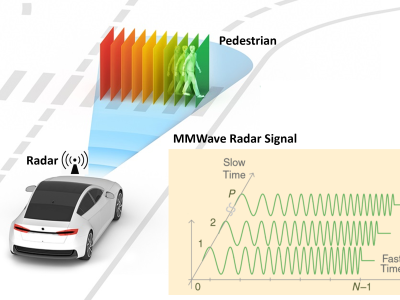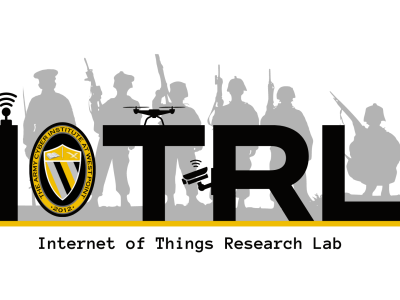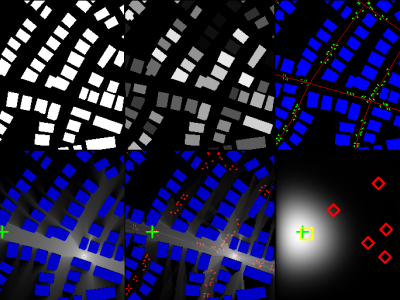CRAWDAD upmc/rollernet

- Citation Author(s):
-
Farid Benbadis (University Pierre and Marie Curie (Paris VI))Jeremie Leguay
- Submitted by:
- CRAWDAD Team
- Last updated:
- DOI:
- 10.15783/C7ZK53
- Data Format:
 153 views
153 views
- Categories:
Abstract
Traces of Bluetooth sightings by groups of rollerbladers carrying iMotes.
This data includes traces of any opportunistic sighting of Bluetooth devices by groups of rollerbladers carrying iMotes in the roller tour in Paris, France.
last modified : 2009-02-10
release date : 2009-02-02
date/time of measurement start : 2006-08-20
date/time of measurement end : 2006-08-20
collection environment : Every Friday evening and every Sunday afternoon in Paris, weather permitting, groups of between 5,000 and 15,000 people go rollerblading. Over the course of three hours, the rollerbladers typically cover 30 km, crossing a large portion of the city. They are guided by staff members and assisted by public safety forces. In order to analyze the mobility of participants, we perform experiments in which we deploy sensors, called iMotes, on approximately a hundred volunteers, who could be organisers' friends, members of rollerblading associations or members of staff. The data set has been collected on August 20, 2006. According to organizers and police information, about 2,500 people participated to the rollerblading tour (few rain showers just before the tour resulted in a number of participants below the average). The total duration of the tour was about three hours, composed of two sessions of 80 minutes, interspersed with a break of 20 minutes. The data that we collect allows us to measure and characterize the interactions between people over the duration of the roller tours. Such information is helpful in the design of new forms of applications in the domains of emergency response, location services, and content delivery. These applications will be available on mobile phones and will take advantage of the ability of phones to communicate directly to other phones in their vicinity, without passing through the traditional cell phone network.
network configuration : In our experiment, 62 iMotes were distributed to a group of people to collect any opportunistic sighting of other Bluetooth devices (including the other iMotes distributed). Our deployment plan was as follows: During an outing, staff members are organized into groups. Over the duration of an outing these groups have an almost static position relative to each other: there are four groups on each side of the crowd, one group at the front, another one at the end, and two groups within the crowd itself. We entrusted iMotes to each group. Deploying in this manner should distribute coverage across the crowd, though we expect that the wireless network will not be fully connected all of the time (indeed, we are interested in studying the disruptions that emerge from changing network conditions for devices of limited range). The remaining iMotes were entrusted to others within the crowd, many of whom did not have assigned positions. In addition to the iMote sensor deployment, we asked other people to activate Bluetooth on their mobile phones.
data collection methodology : The iMotes use Bluetooth technology and log at a high frequency the devices (other iMotes or people's mobile phones) they meet.
sanitization : Volunteers holding iMotes were made aware of the privacy issues related to the experiment: the data that is collected includes the unique identifier of each radio device, and the times when it comes into radio contact with other devices. This data might be associated with descriptive information concerning the individual who bears the device (whether she or he is a staff member or a regular participant, for instance), however the trace data is stored separately from the names of the participants, and RollerMotes forswears any attempt to associate a trace with a person's name. Regarding regular participants who are asked to turn on their Bluetooth devices, we ensure that data are anonymised after the experiment.
Traceset
upmc/rollernet/imote
Traceset of Bluetooth sightings by groups of rollerbladers carrying iMotes.
- description: This traceset includes traces of any opportunistic sighting of Bluetooth devices by groups of rollerbladers carrying iMotes in the roller tour in Paris, France.
- measurement purpose: User Mobility Characterization, Routing Protocol for DTNs (Disruption Tolerant Networks), Location-aware Computing, Social Network Analysis, Content Distribution Evaluation, Opportunistic Connectivity
- methodology: I. Data collection and pre-processing: We tried to keep the processing of data before public release to a minimum, to allow any flexibility for possible research use. Some choices had to be made to reduce power consumption, memory use, and because of specific capabilities of the iMote prototype. Before using these data for your research, it may be important to check that it does not impact any of your findings. 1- periodic desynchronized scanning. In our experiment, iMotes were distributed to a group of people to collect any opportunistic sighting of other Bluetooth devices (including the other iMotes distributed). Each iMote scans on a periodic basis for devices, asking them to respond with their MAC address, via the paging function. It takes approximately 5 to 10s to perform the complete scanning. After initial tests, we observe that most of the contacts were recorded with a 5s scanning time, and this value was used in the experiment. The time granularity between two scannings is 15s. It is important to avoid synchronization of two iMotes around the same cycle clock, as each of them cannot respond to any request when it is actively scanning. Therefore, we implemented a random dephasing on [-5s;+5s] to handle this case. 2- skip-length sequence. A contact "A sees B" is defined as a period of time where all successive scanning by A receive a positive answer by B. Ideally an information should be kept at the end of each contact period. After preliminary test it became quite clear that a very large number of contact periods were only separated by one interval. We decided, to avoid memory overflow, to implement a skip sequence of "one", meaning that a contact period will only be stopped after two successive failure of a scanning response. As a consequence, no inter-contact time of less than two intervals could have been observed. 3- Manual Time synchronization. Time between iMotes is not synchronized by a central entity, and traces belonging to different devices bear times which are relative to the starting time of each device. We recorded the time at which each iMote was first powered up, which corresponds to time 0 at that iMote. After collecting the data, we then converted all times into Unix timestamps (seconds elapsed since 00:00:00 UTC, Jan 1, 1970). II. iMotes deployment In the experiment we performed, we were interested in tracking contacts between different mobile users. The data set has been collected on August 20, 2006. According to organizers and police information, about 2,500 people participated to the rollerblading tour (few rain showers just before the tour resulted in a number of participants below the average). The total duration of the tour was about three hours, composed of two sessions of 80 minutes, interspersed with a break of 20 minutes. During the tour the iMotes has been deployed in three main group of skaters divided as following: --Staff members which are themselves organized into six groups: -Front left and front right -Rear left and rear right -Front and rear. 25 iMotes were entrusted among these six groups. These positions are relative and may have not been always respected by the skaters. There are two iMotes that always stayed at their assignated positions, one at the front and one at the back of the tour. --Skating associations, which receveid 26 iMotes. This is a group of skilled skaters which were expected to be highly mobile --A set of friends which received 11 iMotes. The belonging of each iMote ID to one of these groups is described in the trace configuration section.
- sanitization: To protect participants privacy, we choose not to release the MAC address, neither from the iMotes nor from other external devices recorded. Every device is given a unique identifier, usually called ID number in this document. Depending on which number, it might be an iMote or another MAC address that were recorded from other active Bluetooth devices around.
upmc/rollernet/imote Traces
- contacts: Traces of Bluetooth sightings by groups of rollerbladers carrying iMotes.
- configuration: To ease the understanding of data while keeping a sufficent privacy level, we provide here the group belonging of iMotes ID: - Skaters associations ( skilled skaters ): [1 - 26] - Staff: [27 - 51] 3 Front: 27, 33, 41 2 Front left: 29, 42 4 Front right: 32, 47, 48, 49 5 Rear left: 31, 35, 37, 43, 51 3 Rear right: 34, 44, 45 6 Rear: 28, 36, 38, 40, 46, 50 * Nodes 27 and 38 were respectively known to be always at the head and the tail of the roller tour. * Nodes 30 and 39 were rescuer, not affected to any particular place. - Set of friends: [52 - 62] The 1050 external devices ( cell phones, PDAs ...) have IDs from 63 to 1112. The experiment started on Sunday, 20 Aug 2006 14:24:06 (GMT), and stopped on Sunday, 20 Aug 2006 17:14:00 (GMT).
- format:
The dataset containts two data files as follows:
1. "MAC3Btable.dat"
is a file that contains the three first bytes of the MAC address,
associated with each ID. It could be useful to identify the manufacturer
of each external device.
2. "contacts.dat"
is a file which describes the contact that were recorded by all
devices we distributed during this experiment.
A contact between two devices A and B is reported only once and last
the time that A sees B or B sees A.
========================
Examples taken from table.Exp1.dat (two first columns and first rows)
========================
51 377 1156089135 1156089164 7 498
51 377 1156089399 1156089399 8 235
51 377 1156089428 1156089428 9 29
51 377 1156089569 1156089585 10 141
51 377 1156090078 1156090078 11 493
51 377 1156090532 1156090532 12 454
51 377 1156090833 1156090833 13 301
51 377 1156090914 1156090914 14 81
51 377 1156090946 1156090966 15 32
51 377 1156093426 1156093426 16 2460
51 377 1156093798 1156093798 17 372
51 381 1156088465 1156088465 1 0
51 389 1156087797 1156087797 1 0
51 396 1156085474 1156085474 1 0
51 396 1156085603 1156085603 2 129
51 396 1156087039 1156087051 3 1436
========================
- The first and second columns gives the IDs of the devices of
which the contact is reported.
- The third and fourth column describe, respectively, the first and
last time when:
-the address of ID2 were recorded by ID1
OR
-the adress of ID1 were recorded by ID2 for this contact.
- The fifth and sixth column are here for reading convenience. The
fifth enumerate contacts with same ID1 and ID2, as 1,2,... . The last
column describes the time difference between the beginning of this
contact and the end of the previous contact with same ID1 and ID2. It
is by convention set to 0 if this is the first contact for this ID1
and ID2.
- Times are unix timestamps which correspond to the number of seconds
since midnight January 1, 1970 UTC (referred to as the Epoch).
Instructions:
The files in this directory are a CRAWDAD dataset hosted by IEEE DataPort.
About CRAWDAD: the Community Resource for Archiving Wireless Data At Dartmouth is a data resource for the research community interested in wireless networks and mobile computing.
CRAWDAD was founded at Dartmouth College in 2004, led by Tristan Henderson, David Kotz, and Chris McDonald. CRAWDAD datasets are hosted by IEEE DataPort as of November 2022.
Note: Please use the Data in an ethical and responsible way with the aim of doing no harm to any person or entity for the benefit of society at large. Please respect the privacy of any human subjects whose wireless-network activity is captured by the Data and comply with all applicable laws, including without limitation such applicable laws pertaining to the protection of personal information, security of data, and data breaches. Please do not apply, adapt or develop algorithms for the extraction of the true identity of users and other information of a personal nature, which might constitute personally identifiable information or protected health information under any such applicable laws. Do not publish or otherwise disclose to any other person or entity any information that constitutes personally identifiable information or protected health information under any such applicable laws derived from the Data through manual or automated techniques.
Please acknowledge the source of the Data in any publications or presentations reporting use of this Data.
Citation:
Farid Benbadis, Jeremie Leguay, upmc/rollernet, https://doi.org/10.15783/C7ZK53 , Date: 20090202
















